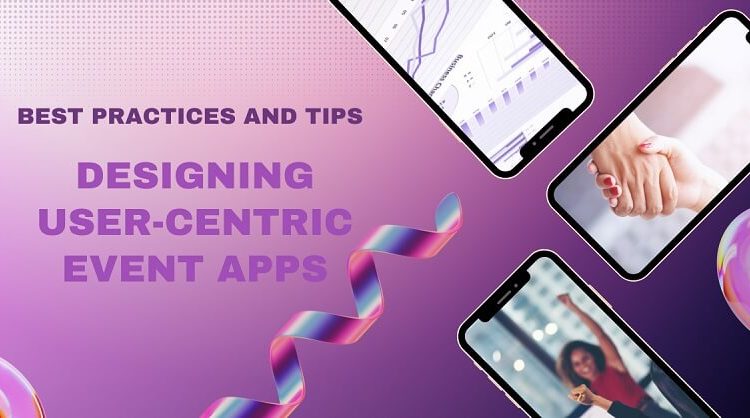Designing User-Centric Event Apps: Best Practices and Tips

In the digital age, event planning has taken a new direction with the advent of event apps. These applications have revolutionized the way attendees interact with events, providing a seamless and immersive experience. However, creating a successful event app requires a deep understanding of user needs and preferences. In this article, we will explore the best practices and tips for designing user-centric event apps that cater to attendees’ expectations and enhance their overall event experience.
Also, see a list of the top 25 event apps in 2024.
Best Practices and Tips for Designing User-Centric Event Apps:
1. Understand Your Audience
Before diving into app development, it’s crucial to gain a clear understanding of your target audience. Consider the demographics, interests, and technological preferences of your potential users. Are they tech-savvy millennials or seasoned professionals? Tailor your app’s design, features, and content to align with their expectations. Conduct surveys, gather feedback from previous events, and analyze user behavior to craft a user-centric app that resonates with your audience.
2. Intuitive User Interface (UI)
Simplicity and intuitiveness should be the cornerstone of your event app’s UI design. Users should be able to navigate the app effortlessly and find the information they need quickly. Implement a clean and consistent design, avoiding clutter and unnecessary complexities. Use clear icons, labels, and menus to guide users through the app’s various sections. Remember, a well-designed UI enhances user engagement and encourages them to explore the app further.
3. Personalization and Customization
Personalization is a powerful tool for creating user-centric event apps. Allow users to customize their app experience based on their preferences. This could include selecting favorite sessions, creating personalized schedules, and receiving tailored recommendations. By providing relevant content and experiences, you can increase user satisfaction and make the app an essential tool for their event journey.
4. Real-time Updates
Events are dynamic, and information can change rapidly. Ensure that your event app provides real-time updates to keep users informed about schedule changes, speaker updates, venue adjustments, and more. Push notifications can be a valuable feature, but use them judiciously to avoid overwhelming users with excessive alerts. Keep the communication timely and relevant to maintain user engagement.
5. Interactive Maps and Wayfinding
Large events often span multiple venues and areas, leading attendees to seek guidance on navigating the event space. Incorporate interactive maps and wayfinding features into your app to help users find their way easily. Include points of interest, session locations, restroom facilities, and food options on the map. Augmented reality (AR) can also add a futuristic touch by providing real-time directions through a smartphone’s camera view.
6. Networking Opportunities
One of the main reasons people attend events is to network and connect with fellow attendees, speakers, and exhibitors. Foster networking within your event app by integrating features that enable attendees to connect with each other. Incorporate profiles, direct messaging, and social media integration to facilitate meaningful interactions. By promoting networking, you enhance the overall value of your event and create a user-centric app experience. Also, you can check Successful Social Media Campaigns you can learn from.
7. Gamification Elements
Gamification can inject an element of fun and excitement into your event app. Create challenges, quizzes, or scavenger hunts that encourage users to explore the app and engage with event content. You can also use WordPress quiz plugins to create and integrate them easily. Reward participants with points, badges, or virtual prizes for completing tasks or attending sessions. Gamification not only keeps users engaged but also encourages them to immerse themselves fully in the event experience.
8. Accessibility Considerations
Designing a user-centric event app also involves making it accessible to a diverse audience, including individuals with disabilities. Ensure that your app adheres to accessibility guidelines, making it usable for people with visual, auditory, or motor impairments. Implement features like alternative text for images, adjustable text sizes, and compatibility with screen readers to ensure that all users can participate in the event digitally.
9. Feedback Mechanisms
Feedback is invaluable for improving future iterations of your event app. Provide users with a way to share their opinions, suggestions, and concerns within the app. This could be through surveys, ratings, or direct feedback forms. Actively listen to user feedback and use it to fine-tune your app’s features and functionalities. Demonstrating that you value user input helps create a user-centric app that evolves with the changing needs of your audience.
You can start building your event app today, with Fliplet.
In conclusion
Designing a user-centric event app requires a holistic approach that takes into account user preferences, technological advancements, and the dynamic nature of events. By understanding your audience, creating an intuitive UI, offering personalization options, and integrating interactive features, you can craft an app that enhances the event experience and leaves attendees delighted. Embrace the power of technology to create a seamless and engaging platform that serves as an indispensable companion for event-goers.

